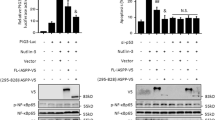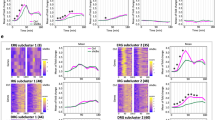Abstract
Neutrophil lactoferrin (Lf) was previously shown to act as a transcriptional activator in various mammalian cells. Here, we describe that Lf specifically transactivates the p53 tumor suppressor gene through the activation of nuclear factor-κB (NF-κB) and consequently regulates p53-responsive oncogenes. In HeLa cervical carcinoma cells stably expressing Lf (HeLa-Lf), expression of mdm2 and p21waf1/cip1 as well as p53 was greatly enhanced. Transient expression of Lf also markedly transactivates transcription of a p53 promoter-driven reporter and NF-κB-driven reporters in various mammalian cells. However, mutation of the NF-κB site or treatment with an NF-κB inhibitor abrogated the transactivation, suggesting that NF-κB should play an essential role in the Lf-induced transactivation. Increased binding activity and nuclear translocation of p65 in response to Lf strongly support these findings. Furthermore, Lf-mediated NF-κB activation is diminished in IKKα- or IKKβ-deficient mouse embryonic fibroblast cells. The activation of both IKKs and NF-κB by Lf is over-ridden by the expression of dominant-negative mutants of NIK, MEKK1, IKKα and IKKβ. Collectively, we conclude that overexpressed Lf directly relays signals to upstream components responsible for NF-κB activation, thereby leading to the activation of NF-κB target genes.
This is a preview of subscription content, access via your institution
Access options
Subscribe to this journal
Receive 50 print issues and online access
$259.00 per year
only $5.18 per issue
Buy this article
- Purchase on Springer Link
- Instant access to full article PDF
Prices may be subject to local taxes which are calculated during checkout








Similar content being viewed by others
References
Andrews NC and Faller DV . (1991). Nucleic Acids Res., 19, 2499.
Bagby Jr GC . (1989). Blood Cells, 15, 386–399.
Baud V and Karin M . (2001). Trends Cell Biol., 11, 372–377.
Baud V, Liu ZG, Bennett B, Suzuki N, Xia Y and Karin M . (1999). Genes Dev., 13, 1297–1308.
El-Deiry WS . (1998). Semin. Cancer Biol., 8, 345–357.
Galbraith PR . (1986). Clin. Invest. Med., 9, 1–5.
Garre C, Bianchi-Scarra G, Sirito M, Musso M and Ravazzolo R . (1992). J. Cell. Physiol., 153, 477–482.
Ginsberg D, Oren M, Yaniv M and Piette J . (1990). Oncogene, 5, 1285–1290.
Haupt Y, Maya R, Kazaz A and Oren M . (1997). Nature, 387, 296–299.
He J and Furmanski P . (1995). Nature, 373, 721–724.
Hellin AC, Calmant P, Gielen J, Bours V and Merville MP . (1998). Oncogene, 16, 1187–1195.
Kastan MB, Zhan Q, el-Deiry WS, Carrier F, Jacks T, Walsh WV, Plunkett BS, Vogelstein B and Fornace Jr AJ . (1992). Cell, 71, 587–597.
Kirch HC, Flaswinkel S, Rumpf H, Brockmann D and Esche H . (1999). Oncogene, 18, 2728–2738.
Lee FS, Peters RT, Dang LC and Maniatis T . (1998). Proc. Natl. Acad. Sci. USA, 95, 9319–9324.
Levine AJ . (1997). Cell, 88, 323–331.
Li Q and Verma IM . (2002). Nat. Rev. Immunol., 2, 725–734.
Lin YZ, Yao SY, Veach RA, Torgerson TR and Hawiger J . (1995). J. Biol. Chem., 270, 14255–14258.
Ling L, Cao Z and Goeddel DV . (1998). Proc. Natl. Acad. Sci. USA, 95, 3792–3797.
Mikogami T, Heyman M, Spik G and Desjeux JF . (1994). Am. J. Physiol., 267, G308–G315.
Oh SM, Hahm DH, Kim IH and Choi SY . (2001). J. Biol. Chem., 276, 42575–42579.
Raman V, Martensen SA, Reisman D, Evron E, Odenwald WF, Jaffee E, Marks J and Sukumar S . (2000). Nature, 405, 974–978.
Regnier CH, Song HY, Gao X, Goeddel DV, Cao Z and Rothe M . (1997). Cell, 90, 373–383.
Schulze-Osthoff K, Ferrari D, Riehemann K and Wesselborg S . (1997). Immunobiology, 198, 35–49.
Shau H, Kim A and Golub SH . (1992). J. Leukocyte Biol., 51, 343–349.
Song HY, Regnier CH, Kirschning CJ, Goeddel DV and Rothe M . (1997). Proc. Natl. Acad. Sci. USA, 94, 9792–9796.
Suzuki YA and Lonnerdal B . (2002). Biochem. Cell Biol., 80, 75–80.
Weng H, Choi SY and Faller DV . (1995). J. Biol. Chem., 270, 13637–13644.
Zhao Q and Lee FS . (1999). J. Biol. Chem., 274, 8355–8358.
Acknowledgements
This work was supported by a grant of the Korea Health 21 R&D Project, Ministry of Health and Welfare, Republic of Korea (to SYC, 02-PJ1-PG3-22005-0016).
Author information
Authors and Affiliations
Corresponding author
Rights and permissions
About this article
Cite this article
Oh, SM., Pyo, CW., Kim, Y. et al. Neutrophil lactoferrin upregulates the human p53 gene through induction of NF-κB activation cascade. Oncogene 23, 8282–8291 (2004). https://doi.org/10.1038/sj.onc.1208021
Received:
Revised:
Accepted:
Published:
Issue Date:
DOI: https://doi.org/10.1038/sj.onc.1208021
Keywords
This article is cited by
-
Human apo-lactoferrin as a physiological mimetic of hypoxia stabilizes hypoxia-inducible factor-1 alpha
BioMetals (2012)
-
Human lactoferrin upregulates BCL-3 in the K562 erythroleukemia cell
BioChip Journal (2011)
-
Probiotic Lactobacillus casei Expressing Human Lactoferrin Elevates Antibacterial Activity in the Gastrointestinal Tract
BioMetals (2010)
-
A critical review of the roles of host lactoferrin in immunity
BioMetals (2010)
-
Porcine lactoferrin as feedstuff additive elevates avian immunity and potentiates vaccination
BioMetals (2010)



